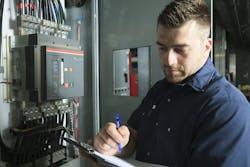Traditionally, we have focused on skill training to prepare electrical workers. Skill alone, however, does not make for a good maintenance electrician. For those skills to be put to best use, a good attitude is essential. Consider:
- Safety comes first. If the electrician’s attitude is that safety gets in the way of work, you have an unsafe electrician. The right attitude is that if the work gets in the way of safety, the work can’t proceed until the conflict is resolved.
- Production is a customer. A good maintenance electrician makes production people feel like valued customers. He listens to their concerns, behaves professionally, and maintains an upbeat, “can do” demeanor. Having the attitude that production people are interrupting your day or bothering you can damage the positive relationships that maintenance needs with other departments.
- I will do it right. When the electrician takes pride in his work and ensures it’s done correctly, everyone has confidence in that person.
About the Author

Mark Lamendola
Mark is an expert in maintenance management, having racked up an impressive track record during his time working in the field. He also has extensive knowledge of, and practical expertise with, the National Electrical Code (NEC). Through his consulting business, he provides articles and training materials on electrical topics, specializing in making difficult subjects easy to understand and focusing on the practical aspects of electrical work.
Prior to starting his own business, Mark served as the Technical Editor on EC&M for six years, worked three years in nuclear maintenance, six years as a contract project engineer/project manager, three years as a systems engineer, and three years in plant maintenance management.
Mark earned an AAS degree from Rock Valley College, a BSEET from Columbia Pacific University, and an MBA from Lake Erie College. He’s also completed several related certifications over the years and even was formerly licensed as a Master Electrician. He is a Senior Member of the IEEE and past Chairman of the Kansas City Chapters of both the IEEE and the IEEE Computer Society. Mark also served as the program director for, a board member of, and webmaster of, the Midwest Chapter of the 7x24 Exchange. He has also held memberships with the following organizations: NETA, NFPA, International Association of Webmasters, and Institute of Certified Professional Managers.
